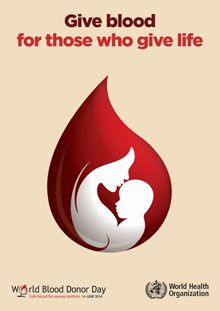 11 June 2014 | Cairo, Egypt – This year’s World Blood Donor Day highlights the fact that safe blood saves the lives of mothers. It is a call to save the lives of the thousands of women worldwide who die every year due to complications related to pregnancy and childbirth.
11 June 2014 | Cairo, Egypt – This year’s World Blood Donor Day highlights the fact that safe blood saves the lives of mothers. It is a call to save the lives of the thousands of women worldwide who die every year due to complications related to pregnancy and childbirth.
The slogan of this year’s World Blood Donor Day campaign is “give blood for those who give life”. The campaign aims to improve access to safe blood to manage pregnancy-related complications as part of a comprehensive approach to maternal care. In doing so, the campaign could help to save the lives of the 800 women who die every day from pregnancy- or childbirth-related complications worldwide.
Almost all maternal deaths due to such complications occur in developing countries. Severe bleeding during delivery and after childbirth is a major cause of mortality, morbidity and long-term disability. Blood transfusion is recognized as a key life-saving intervention for the management of pregnancy- and childbirth-related complications.
On this occasion, Dr Ala Alwan, WHO Regional Director for the Eastern Mediterranean reiterated that “the most common cause of preventable maternal deaths in the Region is severe bleeding. Many of these deaths could be prevented through access to safe blood and blood products.
In several countries, the greatest need for donated blood is for the management of severe anaemia and pregnancy-related complications. As well, in the countries experiencing complex humanitarian emergencies, the safety and availability of blood supply are at risk among affected populations”.
In the Eastern Mediterranean Region, low- and middle-income countries suffer from an acute shortage of safe blood. Most of these countries collect less than half of the blood needed, with an average donation rate of 10 donations per 1000 population. Voluntary non-remunerated blood donors comprise on average 50% of regional donors, ranging between 2% and 100% in some countries. Due to the inadequate supply of blood from voluntary unpaid donors, most countries depend on the families of patients for replacing the blood units required for transfusion.
“The primary challenge to improving blood safety and availability in the Region is the lack of national policies, strategies and action plans that reflect a comprehensive approach to addressing issues of safety, quality, sufficiency, availability and timely accessibility of blood and blood products” Dr Alwan added.


